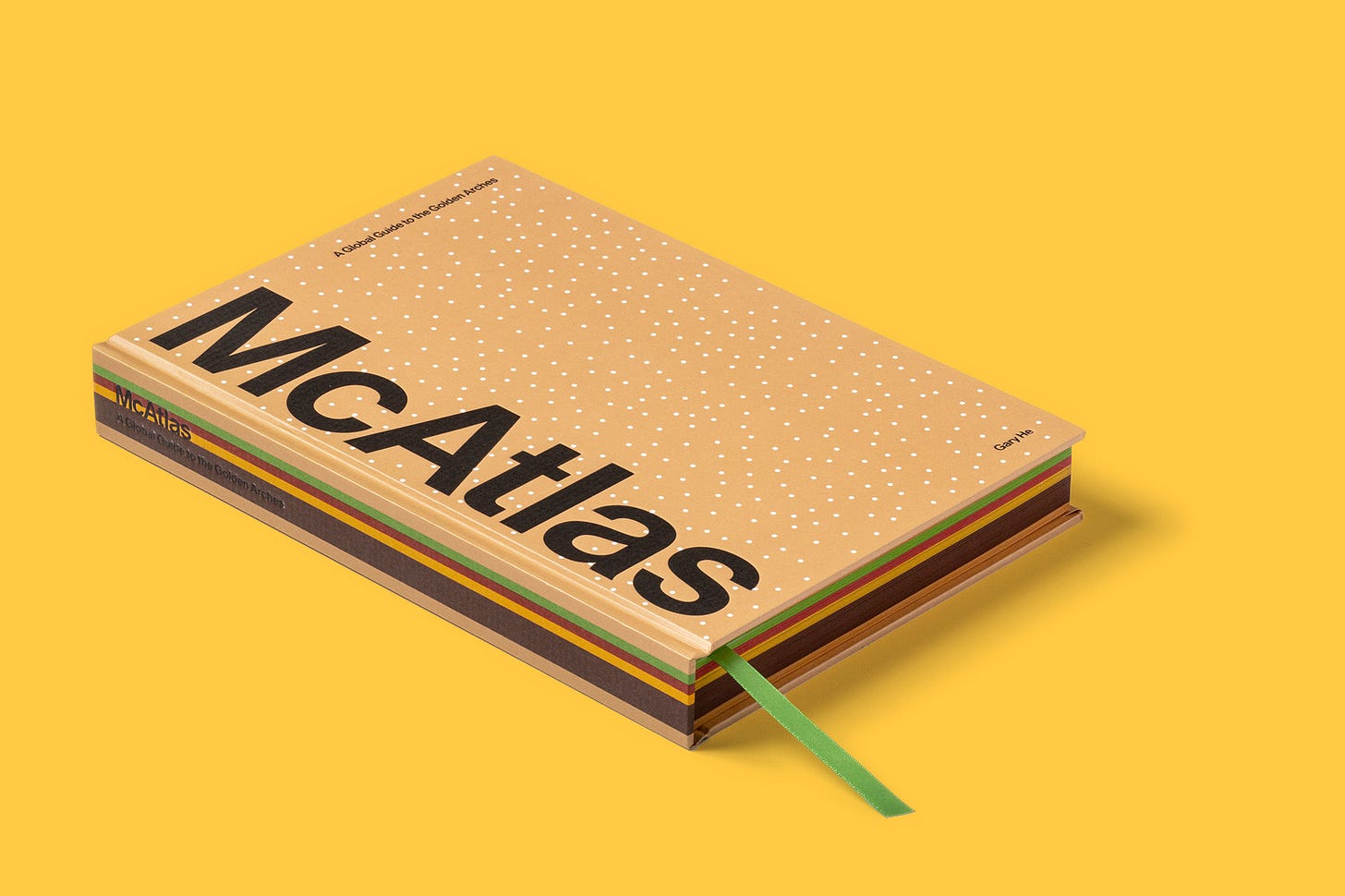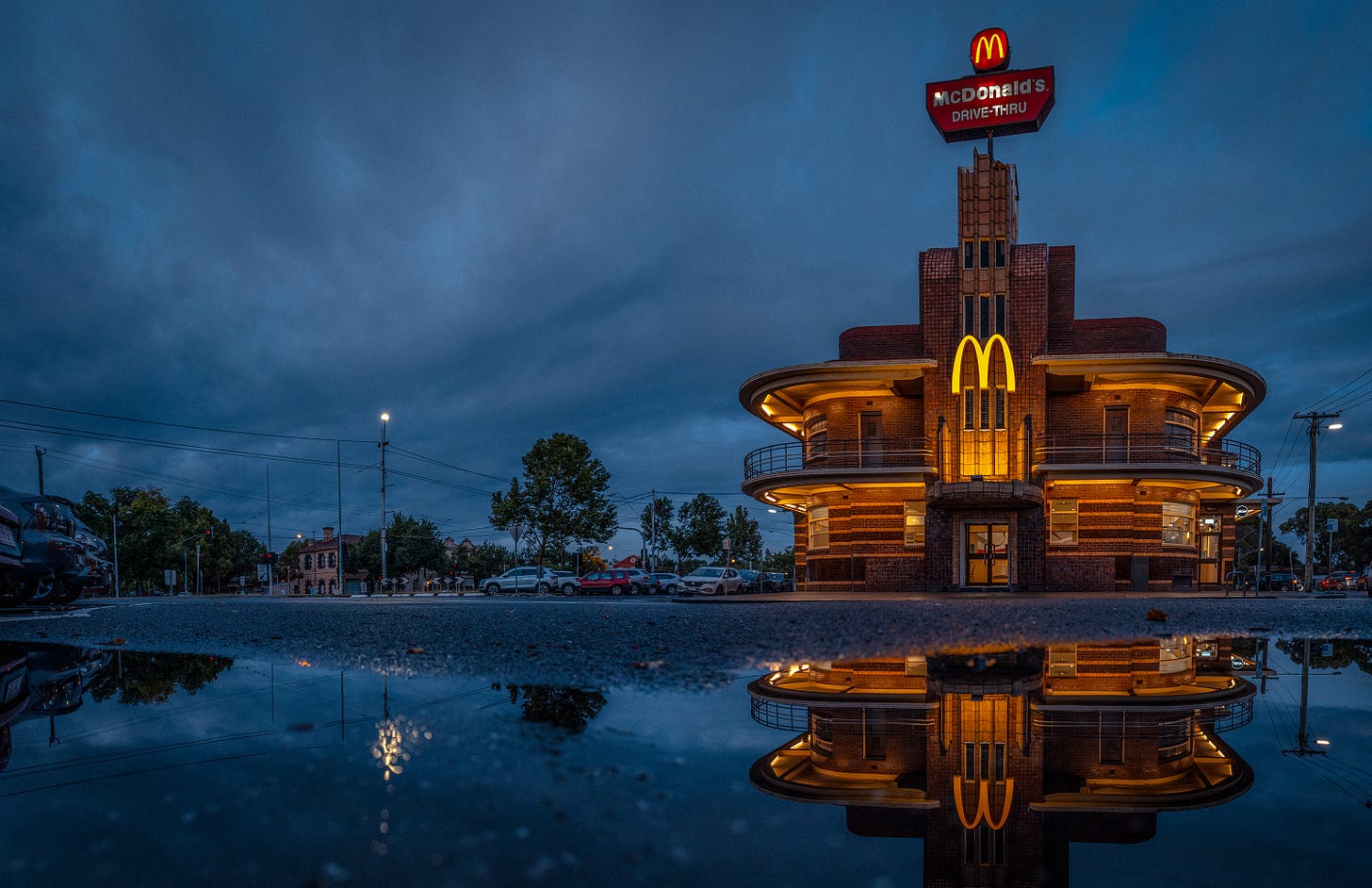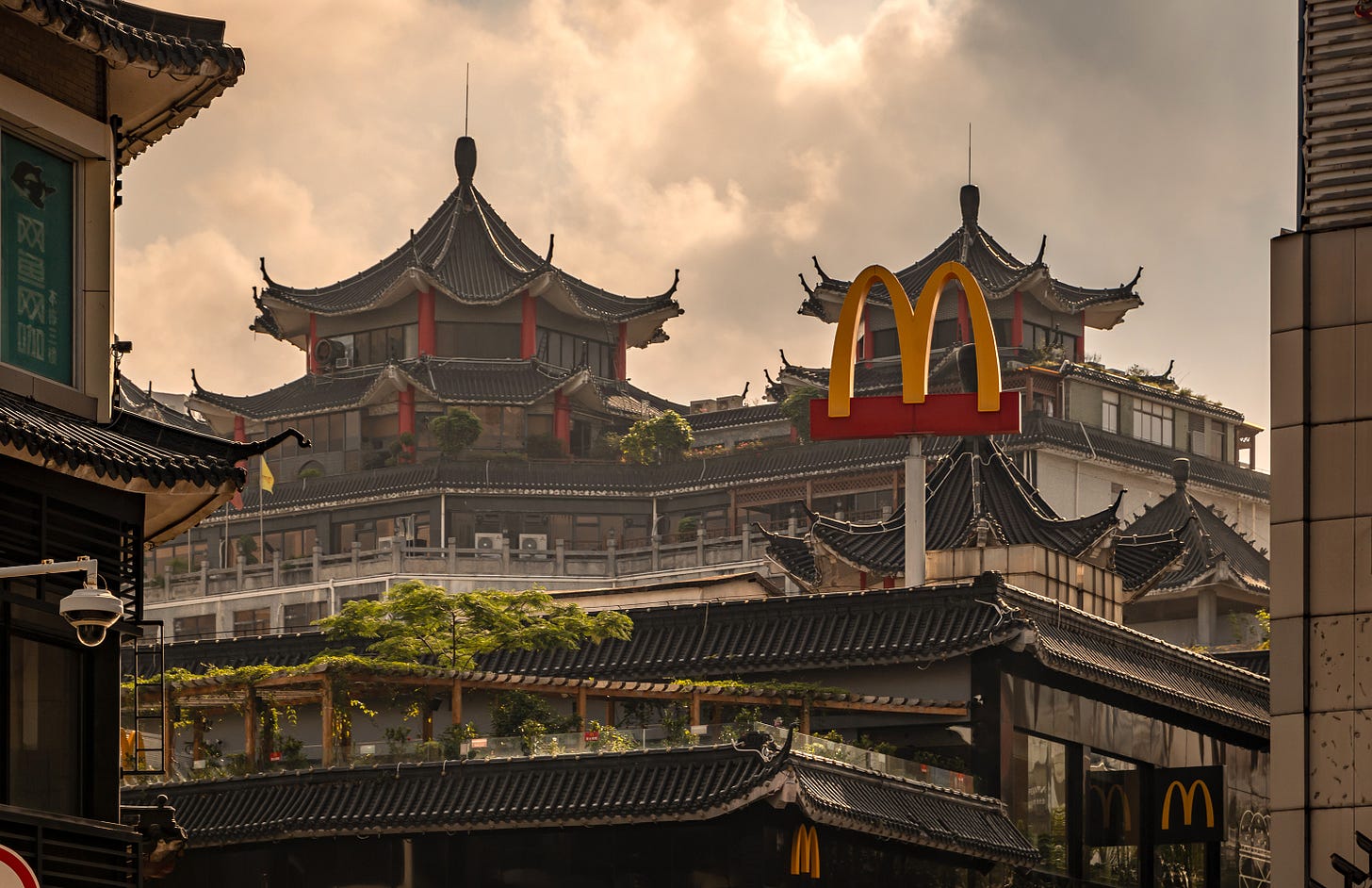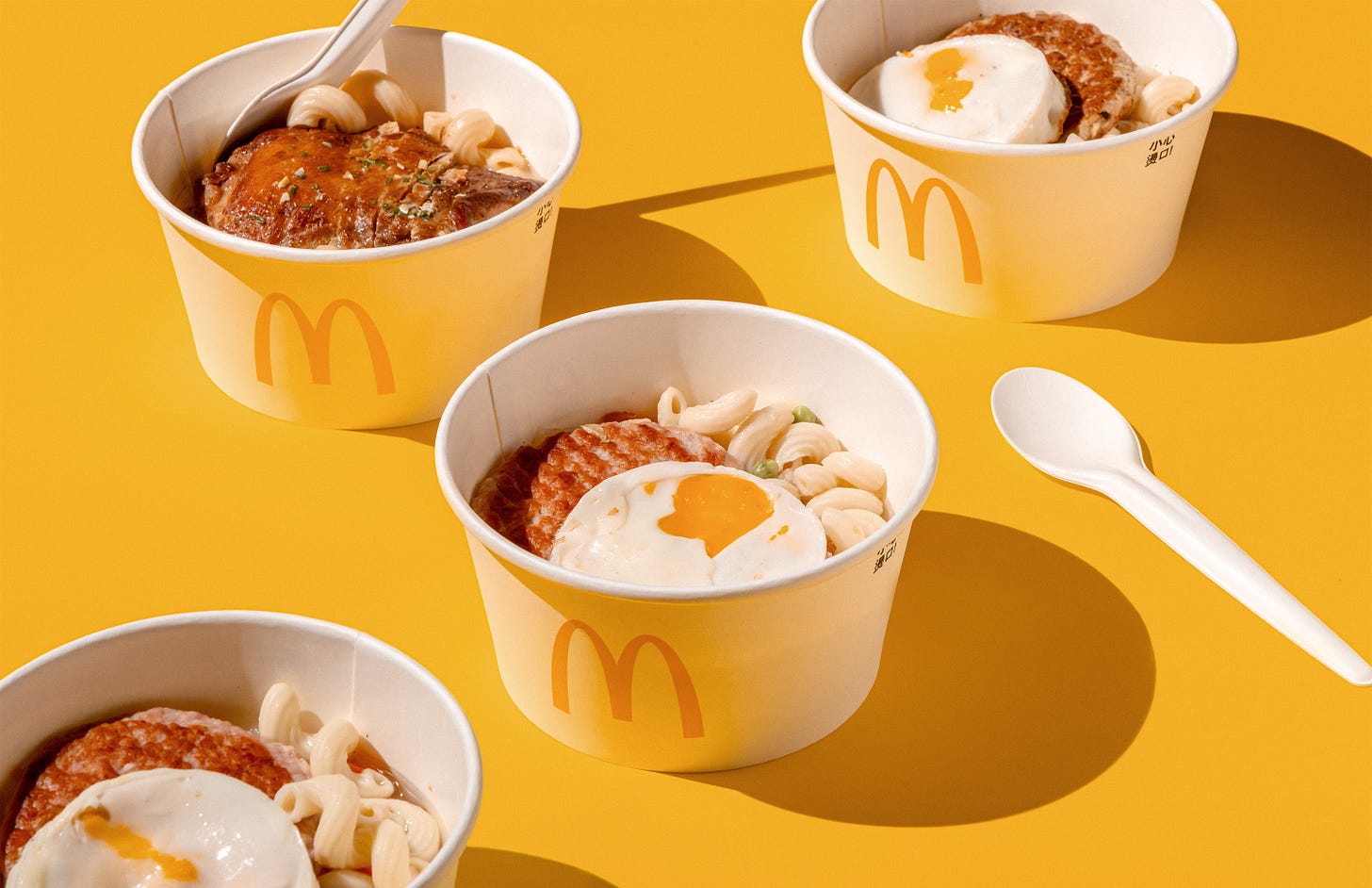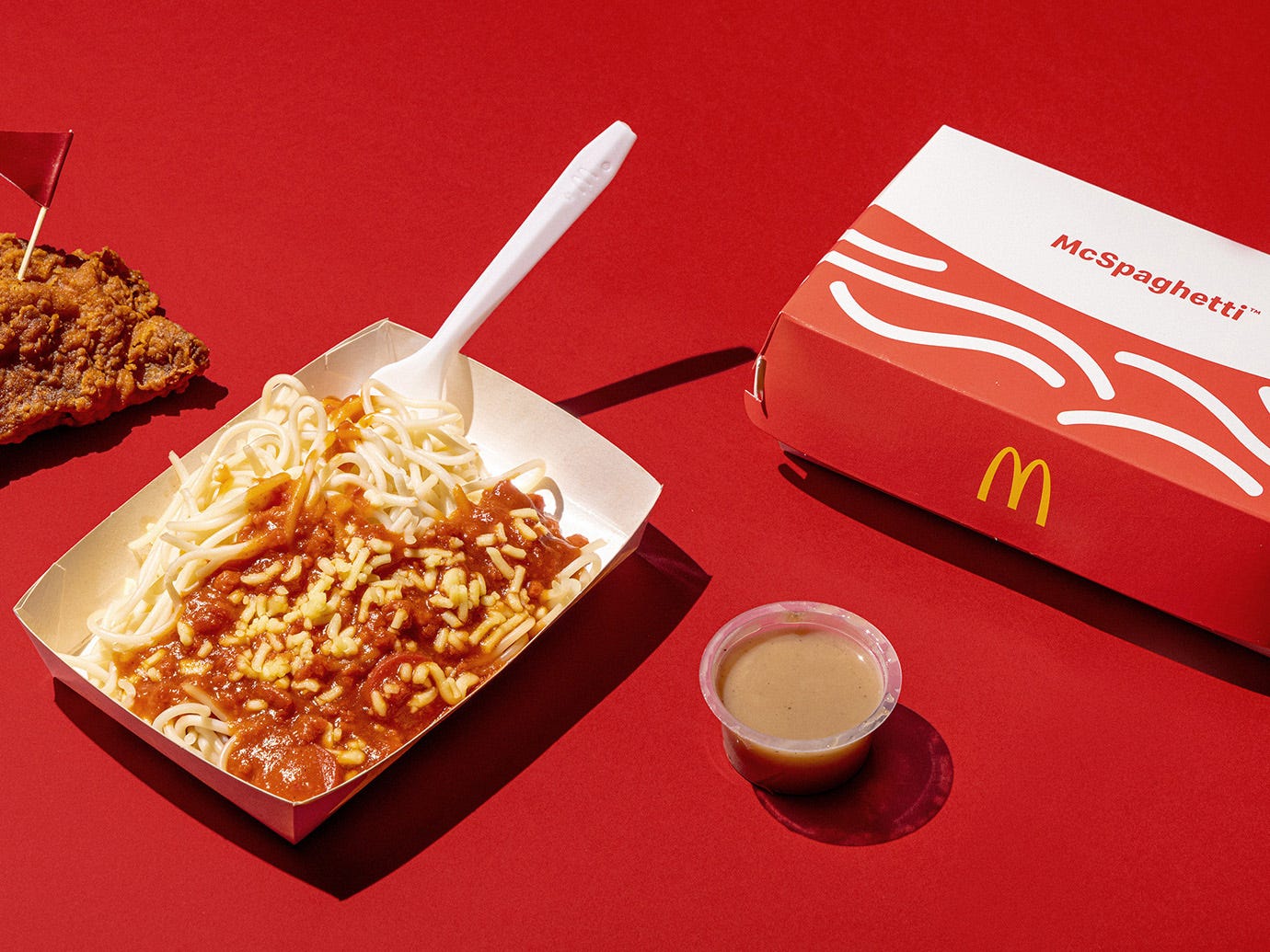Numlock Sunday: Gary He photographs the McDonald's empire
Walt Hickey
Welcome to the Numlock Sunday edition.
This week, I spoke to Gary He, author of McAtlas. This is a gorgeous new coffee table book, a photography-filled deeply-reported round-the-world adventure into one of the most interesting companies on the planet. It is a book that speaks to how we’re all charmingly different but, in many ways, people really are the same all over. It will be a permanent resident of my coffee table.
We spoke about how McDonald's succeeds in markets around the world and the range of its menu adaptations, from India's McAloo Tikki to the Philippines' McSpaghetti.
He can be found on Substack, and the book can be found at McAtlas.com.
This interview has been condensed and edited.
Gary, thank you so much for coming on.
Thanks for having me.
I am really excited to have you. You have a really fascinating new book coming out. I would say it's very artistically driven, but also it's about one of the most interesting geopolitical forces on the planet. Just to back out a bit, what got you interested in McDonald's?
As a food journalist, you always want to cover the big stories, and there's really no bigger story than McDonald's. It's the largest restaurant chain on the planet. Everyone has some sort of relationship with McDonald's, so it's extremely relatable. For me, I grew up eating Happy Meals when I would get a good test score, and then in college, I would survive on the Dollar Menu over at NYU. I've had a lifelong relationship with McDonald's, and when I started going overseas and eating some not-so-typical menu items, it got me interested.
I was doing some research on it and really there wasn't one single place to find all this information. And I said, well, this is incredible. The largest restaurant chain in the world, and this information isn't really being covered anywhere, so I guess it should be me. I guess I should do it. Several years later, here we are at the McAtlas.
I really enjoy how you approach this topic. You are a James Beard Award-winning writer, and you take McDonald's very, very seriously from a culinary perspective. I know you interviewed a Michelin-starred chef that designs burgers for McDonald's. You look at this company as just a very honest distributor of food. How do you look at McDonald's as an entity, as a gustatory enterprise, I suppose?
I feel like when people think about McDonald's, they think it's a monolithic company run out of the West Loop of Chicago, and everything's got this same bland food across the world. But from my travels, I've discovered that it's more of a network of local businesspeople, especially when you talk about the individual markets. It's all these local entrepreneurs that are simply using the assets and the resources of the American brand, applying it and making it their own. Even if we're talking about the same exact item in a place like France or Italy, for example, in the sourcing of the food and how it's processed, they have to adhere to local tastes. It has to be a very localized product.
In the book, in order to paint this picture, the easiest way to do it is to really just go, okay, what are the local menu items? And we go from there. Very early on in the book, we cover the fact that even the makeup of Spicy Chicken McNuggets is different around the world, because what's considered spicy, what the flavor "spicy" is, is different everywhere. But you make those kinds of assumptions. That part is harder to photograph, to visualize. The thing that's really easy to visualize and compile 250-plus photos of are these different menu items. I see it as not a single restaurant, but a network of quite different restaurants around the world. Does that answer your question?
It does, and it also provokes many more. Like, what's different about "spicy" at McDonald's around the world?
In some markets, with the spicy McNuggets, spicy is more of a black pepper taste. In other markets, particularly Southeast Asia, there's more of a chili, pepper type of flavor profile in those McNuggets.
When executives are interviewed about this subject matter, even they point out that menu items that have the same name around the world present differently. Even the content of the meat; in Muslim-majority countries, that meat is all halal, a completely different processing line than meat in America or in the EU, where they have different rules about the use of antibiotics and all that stuff. The food is different. It's a very localized food.
Once I started getting into it, that became very interesting to me, because I don't think most people see it that way. McDonald's is known for its standardization. The project was very interesting to me, and I hope to open up people's eyes about that subject matter.
Tell me about the field work. You've gone to something like over 50 countries. Is that right?
Yeah, 55 or 56 countries. I've lost track of how many countries I've gone to. Somewhere in the 50s.
The field work differs depending on what the country is. In a place like Japan or Hong Kong, part of that is just sitting in the stores and watching the kids come to McDonald's after school to go on dates, do homework and use it as a third space — something that rarely happens in America. In the US, the drive-thru and delivery game is just so strong. Everyone's in their cars. You don't really see it that much.
When I went to Israel, I met up with a professor of sociology from Tel Aviv University. We went to one of the transportation hubs where we watched Israeli soldiers, how they used McDonald's, and how that fit into the constellation of restaurants in that transportation hub. Also, how those other restaurants eventually got McDonald's-ized, or adopted some of the practices of quick service and limited menu offerings that McDonald's brought to that country and to many countries around the world.
The field work involved that. Just a lot of visiting stores and sitting in them and watching how locals interacted inside the stores.
To talk to you a little about my read on some of this stuff, the comparison that I come back to — and I mean no disrespect in any direction about this — is that I grew up Catholic, and the Catholic Church is an institution that has international security over its beliefs, its supply chains, that kind of stuff. It has a fundamental angle that's replicated in every single country in the world, but! It aggressively localizes. It has no delusions about the fact that it's necessary in order to be a resilient international organization to localize and immerse oneself in that. It seems like McDonald's is an extremely successful version of that.
A church of hamburgers.
What are some ways that you saw this institution adapt to countries in an interesting way?
The biggest hurdle that McDonald's probably had to face was India, right? You have a restaurant chain that serves hamburgers but then a country that's mostly vegetarian. The cow is considered an animal of note that you don't really eat.
When they showed up back in the day, all the burgers had to be a different type of meat. At first it was mutton; now it's chicken. Then they had to start adding menu items like the McAloo Tikki, which is a potato- and pea-based patty, that the locals could actually eat. They maintained that family restaurant, kid-friendly vibe that is prevalent around the world. It's one of their selling points, that it is a clean, safe space to bring your children. But the food itself was completely different over there. They couldn't even sell the Big Mac, which was their No. 1 seller around the world. They had to call it the Chicken Maharaja Mac and build a completely new brand identity for that.
They eventually got over that hump and now they've got a couple hundred stores around the country. It's a thriving business. In that way, with these local adjustments, is how it survives and thrives around the world. Same as with the church, I guess.
You mentioned the family-friendly element, that it's safe to take your kids there. What are some other things that are fundamentally inimitable about McDonald's that you cannot boil out, no matter where it goes?
That's tough. There are core menu items, right? If we ignore India for a second, obviously, there are core menu items that are in every McDonald's. The Chicken McNuggets, the french fries, cheeseburger, hamburger, that kind of thing. I think that list of things that cannot be changed gets ever shorter with every new market. You would have never imagined McDonald's selling rice, but they've been selling rice for 20 or 30 years at this point in most of Southeast Asia.
I used to think that list of essential McDonald's core ideas was longer. Actually going around the world and seeing some of these menu variations, there is seemingly no limit to how far the menu itself can be localized. They sell marinated chicken bones in China: scraps of chicken ribs and tailbones marinated and then deep fried, and they just sell them in a box that has the McDonald's logo on it.
I would say that the idea of it being a safe, clean, air-conditioned space is one of the things that's pretty consistent around the world. Other than that, the food varies quite a bit, as you'll see in the book.
I want to talk a little about that. It's a very photography-driven book. It's gorgeous. The design of it is really something to be super proud of. The photography is also such a great way to immerse oneself in actually the food that this institution serves elsewhere. There's a McSpaghetti in the Philippines?
There is. That localization was super necessary because by the time McDonald's arrived in the Philippines, there had already been a local chain growing called Jollibee that basically learned the playbook from McDonald's before it launched. By the time McDonald's showed up, it had a similar menu, similar style of service, but there was also a sweet marinara pasta that they'd already made extremely popular at kids' birthday parties.
For McDonald's to not have that on their menu would be to concede the kids market. So they added the McSpaghetti to the McDonald's Filipino menu, and most American chains that have arrived in the Philippines since then have added some version of that sweet marinara pasta dish to the menu, which goes to show you how essential having this kind of menu localization is to survival in some markets.
That's awesome. Before we wrap everything together, do you have any favorites? Was there anything that you didn't expect McDonald's to make that you tried and ended up liking?
In South Korea, there's an egg bulgogi burger. I consider it to be probably the most delicious menu item on the planet. Another one I saw that's one of my favorite items can be achieved by a menu hack pretty much anywhere else. In Thailand, they serve their pies à la mode. They have a corn pie and a pineapple pie and the apple pie over there, and they just rip the pie in half and dunk it into a cup of soft serve. I think you can achieve that and try that pretty much anywhere else around the world. Give it a shot, because I think that was pretty delicious.
Amazing. We've come so far from merely the Mc10:35. Innovation can be found anywhere. Where can folks find the book?
McAtlas is available on McAtlas.com. There's also a number of stockists, including cooking-focused bookstores like Kitchen Arts & Letters in New York, Now Serving in Los Angeles, and we're adding more by the day. Check out McAtlas.com; there's more about the project there, and of course you can grab a copy of the book.
Excellent. You also have a Substack, as I understand it.
I do. It's poorly updated, but I'll update it over the next couple of days. The book officially launched on Friday — Black Friday.
Edited by Susie Stark.
If you have anything you’d like to see in this Sunday special, shoot me an email. Comment below! Thanks for reading, and thanks so much for supporting Numlock.
Thank you so much for becoming a paid subscriber!
Send links to me on Twitter at @WaltHickey or email me with numbers, tips or feedback at walt@numlock.news.

